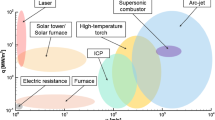For the new generation of space vehicles with a reusable heat shield, it is promising to use carbon-ceramic composite materials resistant to powerful heat flows arising by the descent of such a vehicle in the atmosphere. This paper presents the results of the theoretical forecast of characteristics of a heat shield from a porous carbon–ceramic composite made on the basis of testing specimens of this composite on a gas-dynamic stand simulating real operating conditions of the heat shield. Methods have been developed for simulating the heating and ablation of specimens of carbon–ceramic composites under their convective heating in a plasmatron. It has been established that the diameter of the nozzle of the gas-discharge channel of the plasmatron and its distance to the frontal surface of the specimen influence the temperature regime of tests. We propose an experimental procedure for attaining a temperature of 273 K on the frontal surface of a cylindrical specimen of a carbon–ceramic composite material of diameter 70 mm and height 70 mm.
Similar content being viewed by others
References
V. F. Gladkii, Riddle of the project of the rocket R-3, Aviats. Kosmonavt., No. 11, 13–16 (2002).
T. A. Heppenheimer, Facing the Heat Barrier: A History of Hypersonics: The NASA History Series, Washington, DC (2007) (NASA SP-2007-4232).
S. Reznik, Yuri Gagarin flight and the composite materials and technologies development, in: Proc. 1st Int. Workshop on Advanced Composite Materials and Technologies for Aerospace Applications, 9–11 May 2011, Wrexham, UK (2011), pp. 11–21.
I. S. Prudnikov, Solution of “problem No. 1,” Aviats. Kosmonavt., Nos. 1–2, 19–21 (1994).
Yu. M. Baturin (Ed.), The World Piloted Cosmonautics. History. Equipment. People [in Russian], Izd. “RTSoft,” Moscow (2005).
B. M. Pankratov, Yu. V. Polezhaev, and A. K. Rud′ko, Interaction of Materials with Gas Flows [in Russian], Mashinostroenie, Moscow (1975).
Yu. V. Polezhaev and F. B. Yurevich, Heat Shielding [in Russian], Énergiya, Moscow (1976).
P. V. Nikitin, Thermal Protection [in Russian], Izd. MAI, Moscow (2006).
V. V. Gorskii and P. Ya. Nosatenko, Mathematical Simulation of the Processes of Heat and Mass Transfer in Aerothermochemical Destruction of Composite Heat Shield Silicon-Based Materials [in Russian], Nauchnyi Mir, Moscow (2008).
S. V. Reznik (Ed.), Materials and Coatings under Extreme Conditions. View of the Future, in 3 vols., 1, Forecasting and Analysis of Extreme Effects [in Russian], Izd. MGTU im. N. É. Baumana, Moscow (2002).
M. Ya. Gofin, Heat-Resistant and Heat Shield Structures of Reusable Space Vehicles [in Russian], Mir, St. Petersburg (2003).
P. B. Narottam and L. Jacques, Ceramic Matrix Composites: Materials, Modeling and Technology, WILEY, New York (2015).
S. V. Reznik, K. V. Mikhailovskii, and S. O. Yurchenko, Heat-Resistant Composite Materials Employed in Reusable Objects of Rocket-Space Technology [in Russian], Izd. MGTU im. N. É. Baumana, Moscow (2011).
S. V. Reznik, P. V. Prosuntsov, and K. V. Mikhailovskii, Prediction of thermophysical and thermomechanical characteristics of porous carbon–ceramic composite materials of the heat shield of aerospace craft, J. Eng. Phys. Thermophys., 88, No. 3, 594–601 (2015).
P. V. Prosuntsov and N. Y. Taraskin, Theoretical and numerical characterization of the thermal physical properties of carbon ceramic materials, MATEC Web Conf., 72, 010929 (2016); DOI: https://doi.org/10.1051/matecconf/20167201092.
V. Frolov and D. Ivanov, Development of mathematical models of thermal plasma processes, Proc. III Int. Sci.-Tech. Conf. “INNOVATIONS,” 204–207 (2017).
V. I. Sakharov, Numerical simulation of thermally and chemically nonequilibrium flows and heat transfer in underexpanded jets of the induction plasmatron, Izv. Ross. Akad. Nauk, Mekh. Zhidk. Gaza, No. 6, 157–168 (2007).
A. N. Gordeev, A. F. Kolesnikov, and V. I. Sakharov, Flow and heat transfer in underexpanded jets of the induction plasmatron, Izv. Ross. Akad. Nauk, Mekh. Zhidk. Gaza, No. 4, 130–142 (2011).
A. N. Gordeev, A. F. Kolesnikov, and V. I. Sakharov, Flow and heat transfer in underexpanded jets of carbon dioxide: experiment on an induction plasmatron and numerical simulation, Teplofiz. Vys. Temp., 53, Issue 2, 284–290 (2015).
V. I. Kostikov and A. N. Varenkov, Superhigh-Temperature Composite Materials [in Russian], Intermet Inzhiniring, Moscow (20030.
I. K. Kikoin (Ed.), Tables of Physical Quantities: Handbook [in Russian], Atomizdat, Moscow (1976).
Author information
Authors and Affiliations
Corresponding author
Additional information
Translated from Inzhenerno-Fizicheskii Zhurnal, Vol. 92, No. 1, pp. 93–99, January–February, 2019.
Rights and permissions
About this article
Cite this article
Reznik, S.V., Prosuntsov, P.V. & Mikhailovskii, K.V. Development of Elements of Reusable Heat Shields from a Carbon–Ceramic Composite Material 1. Theoretical Forecast. J Eng Phys Thermophy 92, 89–94 (2019). https://doi.org/10.1007/s10891-019-01910-0
Received:
Published:
Issue Date:
DOI: https://doi.org/10.1007/s10891-019-01910-0



